
GINZA CONNECTIVE
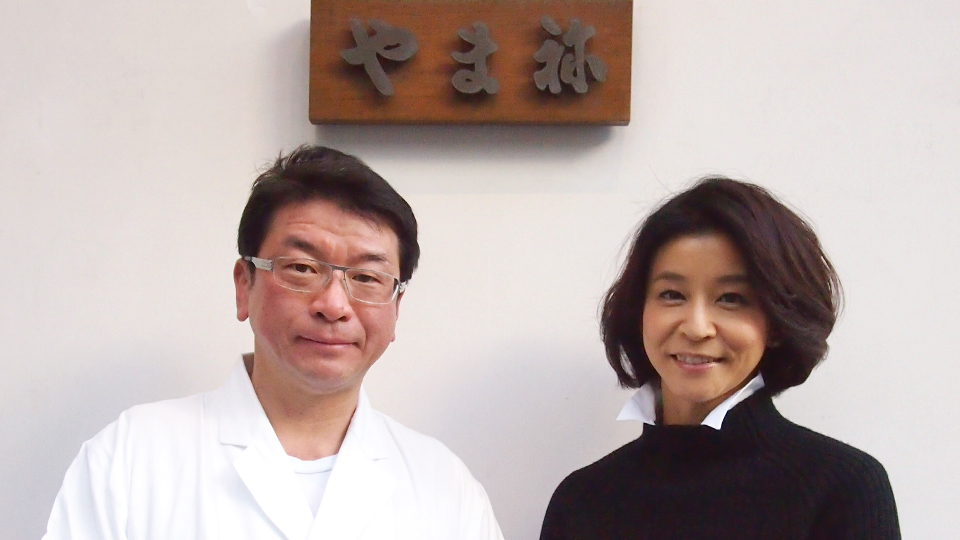
GINZA CONNECTIVE VOL.40
Atsushi Yamane×Chisako Takashima
2015.02.13
An interview series featuring Ginza people in conversation with violinist Chisako Takashima. With a special fondness for Ginza, where she has many memories from both her professional and private life, Takashima explores Ginza from various dimensions with her guests. In this volume, she welcomes Mr. Atsushi Yamane, CEO of Yamane, a high-class Japanese restaurant specializing in blowfish from 1935 (Showa 10).
A long-established restaurant founded in 1935 specializing in blowfish: Nidanbiki, a traditional method of carving sashimi.
- Takashima
- For how many generations have you been in business?
- Yamane
- Although I am the second son, I inherited the family business, so that makes me the fourth generation.
- Takashima
- Have you always been located in Ginza?
- Yamane
- No, our restaurant was first established in Fukuoka in 1935 (Showa 10). We moved to Ginza later in 1954 (Showa 29), so we were already in Ginza in the times of our founder.
- Takashima
- I’ve been told that your blowfish fritters were first served in Ginza.
- Yamane
- Yes, Yamane’s blowfish fritters were invented by the oo-okami (senior proprietress) and okami (proprietress). As we serve a lot of sashimi, we always end up with a great amount of the bony parts of the blowfish, which was originally deep fried to be consumed by our culinary staff. But because the fritters were so tasty, they eventually appeared on our menu.
- Takashima
- I see. I love oily dishes. The blowfish does not have a strong flavor, so I am always delighted when fritters are served in the middle of a course dinner.
- Yamane
- Fortunately, our customers enjoy them too.
- Takashima
- The sashimi is presented beautifully. I recall that blowfish sashimi became popular after Mr. Shigeo Nagashima swept a piece up with his chopsticks and popped it into his mouth.
- Yamane
- Our sashimi is carved using a unique method called nidan-biki that makes each piece twice as thick as normal slices. I would imagine that it would be difficult to bite through our sashimi if it was eaten in that way. I make a second cut in each thinly carved slice. The sashimi is served with a sprinkle of finely chopped green onion.
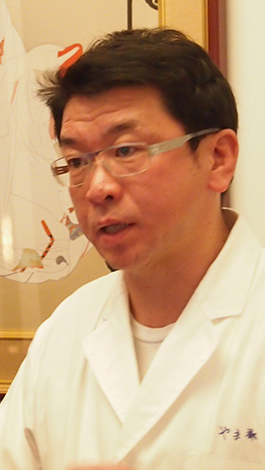
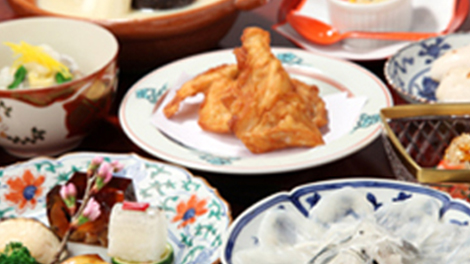
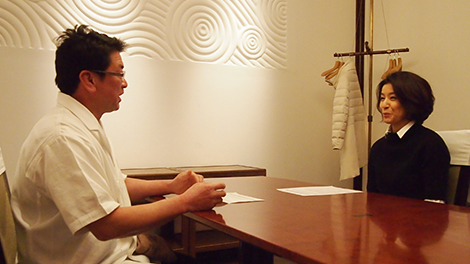
Tokyo’s strict “Blowfish License.” Occasional sore hands from the poison
- Takashima
- I enjoy blowfish cuisine when I visit Shimonoseki for concerts, but it is such a luxury that I don’t often have that opportunity…
- Yamane
- Blowfish has the established image of being a luxury because the blowfish bought in Tokyo today is very expensive, but it was actually widely consumed by the common people in the Edo era.
- Takashima
- Really!
- Yamane
- Before the poison was studied, people ate the blowfish that they caught themselves. Now, we have a law that only allows those of us with licenses to prepare blowfish.
- Takashima
- Is it difficult to get the blowfish license?
- Yamane
- The exam for the license differs among local governments. Tokyo is one of the strictest. That is why, if you acquire your license in Tokyo, it is valid everywhere, while those who obtained their license outside of Tokyo must apply for the Tokyo license if they want to open a restaurant in Tokyo.
- Takashima
- Oh, I wasn’t aware of that. How much poison does a blowfish have?
- Yamane
- All internal organs, including the ovary, liver and kidneys are all toxic. The poisonous parts vary depending on the species of blowfish, but basically, 40-50% of their body carries poison. Little is edible.
- Takashima
- Is it lethal?
- Yamane
- Well, it seems that some people used to enjoy the stimulus of just a little poison, but that is out of the question in Tokyo, in legal terms as well. People can die from suffocation by the poison.
- Takashima
- Oh no! And some people would try to eat it! I wonder if they had wanted to boast to others that they had survived the poison?
- Yamane
- I guess humans can be acquisitive. Of course, I have never tried eating the poison, but because I touch the poison every day, my hands are always sore, so I know that it is strong.
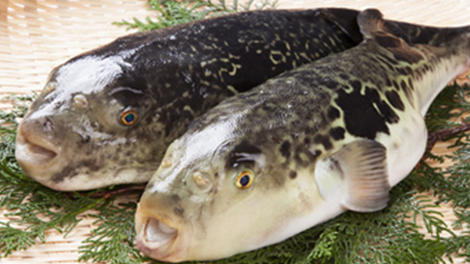
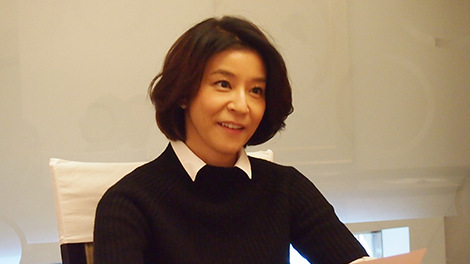
1 2
All List
- GINZA CONNECTIVE VOL.0 Ryo Sayegusa×Chisako Takashima
- GINZA CONNECTIVE VOL.1 Toshiyuki Kosaka×Chisako Takashima
- GINZA CONNECTIVE VOL.2 Yasuharu Mizuhara×Chisako Takashima
- GINZA CONNECTIVE VOL.3 Hitoshi Ishihara×Chisako Takashima
- GINZA CONNECTIVE VOL.4 Shinji Hara×Chisako Takashima
- GINZA CONNECTIVE VOL.5 Choichiro Motoyama×Chisako Takashima
- GINZA CONNECTIVE VOL.6 Noriko Okazoe×Chisako Takashima
- GINZA CONNECTIVE VOL.7 Choichiro Motoyama×Chisako Takashima
- GINZA CONNECTIVE VOL.8 Sayuri Yamaguchi×Chisako Takashima
- GINZA CONNECTIVE VOL.9 Yoshiki Tani×Chisako Takashima
- GINZA CONNECTIVE VOL.10 Yoshifumi Itoh×Chisako Takashima
- GINZA CONNECTIVE VOL.11 Kunihiko Miwa×Chisako Takashima
- GINZA CONNECTIVE VOL.12 Shin Watanabe×Chisako Takashima
- GINZA CONNECTIVE VOL.13 Akihiko Tsuda×Chisako Takashima
- GINZA CONNECTIVE VOL.14 Rie Horikawa×Chisako Takashima
- GINZA CONNECTIVE VOL.15 Jun Takahashi×Chisako Takashima
- GINZA CONNECTIVE VOL.16 Yusuke Harada×Chisako Takashima
- GINZA CONNECTIVE VOL.17 Lintaro Mizuhara×Chisako Takashima
- GINZA CONNECTIVE VOL.18 Keisuke Anzai×Chisako Takashima
- GINZA CONNECTIVE VOL.19 Hozu Yamamoto×Chisako Takashima
- GINZA CONNECTIVE VOL.20 Koji Shibata×Chisako Takashima
- GINZA CONNECTIVE VOL.21 Kayo Hosono×Chisako Takashima
- GINZA CONNECTIVE VOL.22 Mitsuru Saito×Chisako Takashima
- GINZA CONNECTIVE VOL.23 Akihisa Kawaguchi×Chisako Takashima
- GINZA CONNECTIVE VOL.24 Mamoru Sugiyama×Chisako Takashima
- GINZA CONNECTIVE VOL.25 Michiaki Kumagai×Chisako Takashima
- GINZA CONNECTIVE VOL.26 Shinichi Tanizawa×Chisako Takashima
- GINZA CONNECTIVE VOL.27 Koichi Suzuki×Chisako Takashima
- GINZA CONNECTIVE VOL.28 Munehito Matsuzaki×Chisako Takashima
- GINZA CONNECTIVE VOL.29 Hiroshi Hara × Chisako Takashima
- GINZA CONNECTIVE VOL.30 Shigeyuki Ando×Chisako Takashima
- GINZA CONNECTIVE VOL.31 Yukichi Ishikura × Chisako Takashima
- GINZA CONNECTIVE VOL.32 Seiko Yamada × Chisako Takashima
- GINZA CONNECTIVE VOL.33 Mami Nagai × Chisako Takashima
- GINZA CONNECTIVE VOL.34 Ryuta Takahashi × Chisako Takashima
- GINZA CONNECTIVE VOL.35 Kazumasa Osumi×Chisako Takashima
- GINZA CONNECTIVE VOL.36 Masahiro Kameoka×Chisako Takashima
- GINZA CONNECTIVE VOL.37 Shoichiro Watanabe×Chisako Takashima
- GINZA CONNECTIVE VOL.38 Keiji Niimoto×Chisako Takashima
- GINZA CONNECTIVE VOL.39 Chieko Nakamura ×Chisako Takashima
- GINZA CONNECTIVE VOL.40 Atsushi Yamane×Chisako Takashima
- GINZA CONNECTIVE VOL.41 Masaya Shibuya×Chisako Takashima
- GINZA CONNECTIVE VOL.42 Makoto Suzuki×Chisako Takashima
- GINZA CONNECTIVE VOL.43 Masaya Konaka×Chisako Takashima
- GINZA CONNECTIVE VOL.44 Masakazu Tanaka×Chisako Takashima
- GINZA CONNECTIVE VOL.45 Koko Kameoka × Chisako Takashima
- GINZA CONNECTIVE VOL.46 Jin Hirayama×Chisako Takashima
- GINZA CONNECTIVE VOL.47 Takashi Hoshihara×Chisako Takashima
- GINZA CONNECTIVE VOL.48 Mikiko Kimura × Chisako Takashima
- GINZA CONNECTIVE VOL.49 Keisuke Okamoto×Chisako Takashima
- GINZA CONNECTIVE VOL.50 Akira Ito × Chisako Takashima
- GINZA CONNECTIVE VOL.51 Tatsuhiko Adachi × Chisako Takashima
- GINZA CONNECTIVE VOL.52 Masahiko Yamano×Chisako Takashima
- GINZA CONNECTIVE VOL.53 Kiyoshi Kanazashi×Chisako Takashima
- GINZA CONNECTIVE VOL.54 Noriyuki Tsuji×Chisako Takashima
- GINZA CONNECTIVE VOL.55 Shoichi Kobayashi×Chisako Takashima
- GINZA CONNECTIVE VOL.56 Isao Nanjo×Chisako Takashima
- GINZA CONNECTIVE VOL.57 Shinobu Mitsuoka×Chisako Takashima
- GINZA CONNECTIVE VOL.58 Motoyoshi Yasuda×Chisako Takashima
- GINZA CONNECTIVE VOL.59 Toru Fujiki×Chisako Takashima
- GINZA CONNECTIVE VOL.60 Yuji Ida×Chisako Takashima
- GINZA CONNECTIVE VOL.61 Hitoshi Miki×Chisako Takashima
- GINZA CONNECTIVE VOL.62 Takehiko Furuya× Chisako Takashima
- GINZA CONNECTIVE VOL.63 Naoki Yoshizawa×Yusuke Yoshizawa×Chisako Takashima
- GINZA CONNECTIVE VOL.64 Kazuhito Kawase × Chisako Takashima
- GINZA CONNECTIVE VOL.65 Toshiji Yuki× Chisako Takashima
- GINZA CONNECTIVE VOL.66 Hikoyuki Yamaguchi×Chisako Takashima
- GINZA CONNECTIVE VOL.67 Daisuke Nagano×Chisako Takashima
- GINZA CONNECTIVE VOL.68 Shuichi Motohashi× Chisako Takashima
- GINZA CONNECTIVE VOL.69 Shinpei Tonaka×Chisako Takashima
- GINZA CONNECTIVE VOL.70 Shinya Kanematsu × Sachiko Takashima
- GINZA CONNECTIVE VOL.71 Masataka Yano×Chisako Takashima
- GINZA CONNECTIVE VOL.72 Mitsuhiro Kurokawa× Chisako Takashima
- GINZA CONNECTIVE VOL.73 Ryo Saegusa×Chisako Takashima








